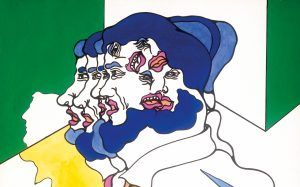Tim Martin in New Statesman:
 Seventy-five years ago, in April 1943, the research chemist Albert Hofmann did something distinctly out of scientific character. Impelled by what he later called a “peculiar presentiment”, he resolved to take a second look at the 25th in a series of molecules derived from the ergot fungus, a drug he had discovered some years earlier and dismissed as of no scientific interest. As he synthesised it for the second time, it made contact with his skin, giving rise to an unprecedented experience: a “stream of fantastic pictures [and] extraordinary shapes with intense, kaleidoscopic play of colours”. Five days later, on 19 April, he decided to test the chemical on himself under controlled conditions, thus becoming the first person in history knowingly to embark on an acid trip.
Seventy-five years ago, in April 1943, the research chemist Albert Hofmann did something distinctly out of scientific character. Impelled by what he later called a “peculiar presentiment”, he resolved to take a second look at the 25th in a series of molecules derived from the ergot fungus, a drug he had discovered some years earlier and dismissed as of no scientific interest. As he synthesised it for the second time, it made contact with his skin, giving rise to an unprecedented experience: a “stream of fantastic pictures [and] extraordinary shapes with intense, kaleidoscopic play of colours”. Five days later, on 19 April, he decided to test the chemical on himself under controlled conditions, thus becoming the first person in history knowingly to embark on an acid trip.
Intermittently ever since, psychonauts and countercultural enthusiasts have celebrated 19 April as “Bicycle Day”, in recognition of this Ground Zero of Western psychedelia. After cautiously ingesting a dose of LSD-25, Hofmann enlisted the help of a lab assistant and wobbled home on his bicycle, while his vision “wavered and distorted as though in a curved mirror”. Sprawled on the sofa, he underwent a “severe crisis” that, viewed through the telescope of 75 years of psychedelic experience, looks endearingly familiar: one in which demonic terrors, mystical encounters and loss of ego alternated with fantastic imagery, synaesthetic perception and a desire to drink “more than two litres” of the milk provided by a neighbour. This year, however, those celebrating Bicycle Day did so against a new background. After decades in the shadow of the 1960s counterculture, psychedelic drugs have emerged once again into the light of scientific orthodoxy. Researchers at major universities – Johns Hopkins in the US, Imperial College in London – have, over the past 20 years, been conducting experiments at growing scale to assess the effects of substances such as LSD, MDMA and psilocybin, the psychedelic compound in magic mushrooms. Their results suggest that these powerful molecules, long stigmatised as drugs of self-gratification or abuse, may instead be miracle treatments for the most intractable disorders of our time: depression, isolation, addiction and post-traumatic stress.
More here.
